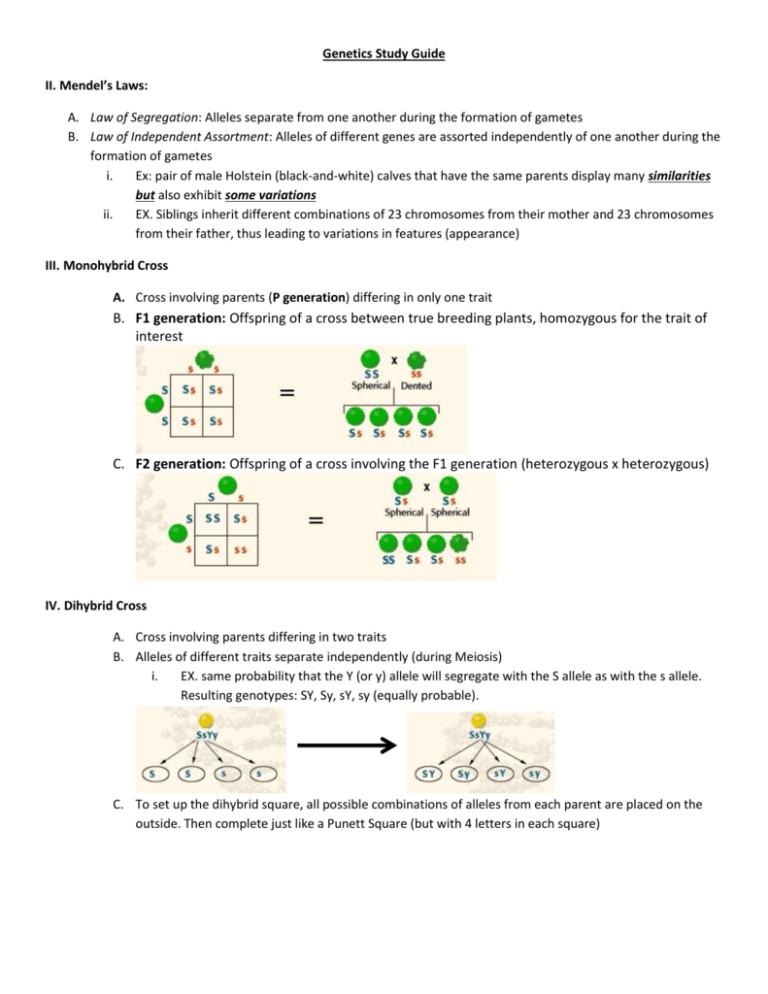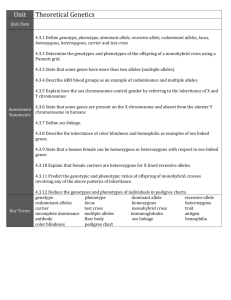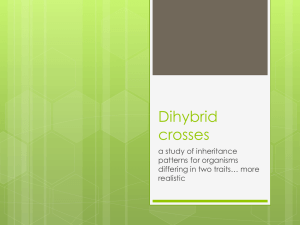Mendalian Genetics Study Guide
advertisement

Genetics Study Guide II. Mendel’s Laws: A. Law of Segregation: Alleles separate from one another during the formation of gametes B. Law of Independent Assortment: Alleles of different genes are assorted independently of one another during the formation of gametes i. Ex: pair of male Holstein (black-and-white) calves that have the same parents display many similarities but also exhibit some variations ii. EX. Siblings inherit different combinations of 23 chromosomes from their mother and 23 chromosomes from their father, thus leading to variations in features (appearance) III. Monohybrid Cross A. Cross involving parents (P generation) differing in only one trait B. F1 generation: Offspring of a cross between true breeding plants, homozygous for the trait of interest C. F2 generation: Offspring of a cross involving the F1 generation (heterozygous x heterozygous) IV. Dihybrid Cross A. Cross involving parents differing in two traits B. Alleles of different traits separate independently (during Meiosis) i. EX. same probability that the Y (or y) allele will segregate with the S allele as with the s allele. Resulting genotypes: SY, Sy, sY, sy (equally probable). C. To set up the dihybrid square, all possible combinations of alleles from each parent are placed on the outside. Then complete just like a Punett Square (but with 4 letters in each square) Remember: The phenotypic ratio for a Heterozygous x Heterozygous Dihybrid cross is ALWAYS 9:3:3:1 V. Incomplete Dominance: A. Neither allele is dominant, and the hybrid phenotype is a mixture of the two parents (Heterozygous genotype) i. EX. Pink flowers VI. Co-dominance: A. Two different alleles at a locus (location) are responsible for different phenotypes that are expressed equally (Heterozygous genotype) i. EX. A cross of a black chicken (BB) and a white chicken (WW) produces all speckled offspring (BBWW) ii. Hybrid Tiger Rose VII. Polygenic (Multiple Alleles) A. Multiple alleles that code for the same phenotypic trait i. EX. Eye color ii. EX. Blood type (also is an example of Codominance) iii. Skin Color (Trihybrid Cross) VIII. Sex-Linked: A. A gene coded on a sex chromosome i. EX. Males only have 1 X chromosome, if the X chromosome is affected they will present with the disorder (Colorblindness) VIV. Other Types of Gene Expression A. Epistasis: One gene alters the expression of a different gene for a different trait i. EX. Labs (Black is dominant to brown but there is another gene that determines if black or brown pigment will be deposited in hair) B. Pleiotropic: A single gene determines more than one phenotype for an organism (multiple symptoms associated with Sickle-Cell Anemia, Cystic Fibrosis Information and Practice Problems (Monohybrid, Test Cross, Dihybrid, Incomplete Dominance, Codominance/Multiple Alleles, Polygenic, Sex-Linked, Epistasis) http://biology.clc.uc.edu/courses/bio105/geneprob.htm Information and Practice Problems (Monohybrid, Dihybrid and Incomplete Dominance): http://www.biology.arizona.edu/mendelian_genetics/mendelian_genetics.html Practice Problems: http://www.biology.arizona.edu/mendelian_genetics/problem_sets/monohybrid_cross/monohybrid_cross.html








